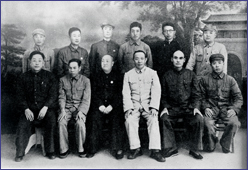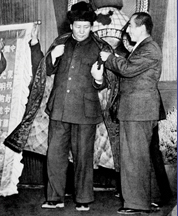|

The first session of Chinese People's Political Consultative Conference (CPPCC)was held on September 21,1949. This is a photo of the third group of ethnic minority delegates. Front row (left)-Zhu Dehai, WangGuoxing, Kui Bi, Zhang Chong,Wu Hongbin, Jin Hanwen. Back row (left)-Tiban Bao,Liu Geping,Duojie Caidan,Yang Jianren,Bai Shouyi,Zhu Zaoguan. [Photo by Cheng Weidong]
|

At the first session of CPPCC in 1949, Seypidin Eziz, delegate of different ethnic groups in Xinjiang Uygur Autonomous Region, presented ethnic clothing to Chairman Mao. [Photo by Cheng Weidong] |
The national program formulated for China's national democratic revolutionary movement at the second National Congress of the Communist Party of China (CPC) in July 1922 was to "end internal disorder, eliminate the warlords, achieve internal peace, terminate the oppression of world imperialism, gain total independence for the Chinese nation, create a true democratic republic by unifying China (including the three provinces in Northeast China), win regional autonomy for Mongolia, Tibet and Xinjiang..."
|



